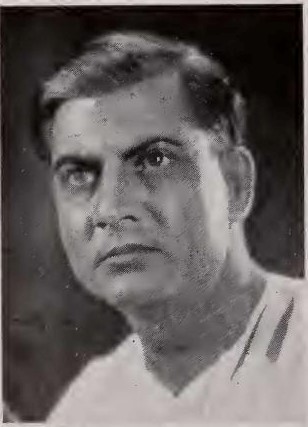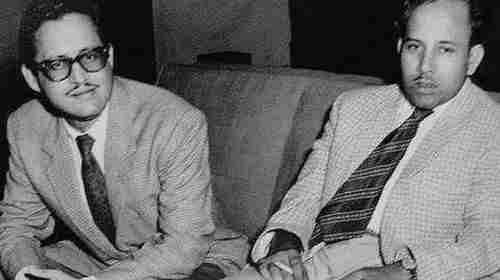“Bharosa” Beats “Pukar” in Purpose!
Subscribe to read full article
This section is for paid subscribers only. Our subscription is only $37/- for one full year.
You get unlimited access to all paid section and features on the website with this subscription.
Not ready for a full subscription?
You can access this article for $2, and have it saved to your account for one year.
A producer’s effort must be judged by his own standard-standard which he has established for him-self in his previous pictures. It will be idle to compare a Minerva picture with a Prabhat product, but it can certainly be compared with the previous productions of the same company.
Compared thus “Bharosa” has more purpose than “Pukar” because of its social theme, it is better directed than any previous picture of Minerva, it has better photography and sound than all Minerva pictures and it has more production values than “Pukar”. “Defeat” and “The Will’ put together.
I therefore welcome “Bharosa” as a sign of progress in future Minerva productions and congratulate Sohrab Mody, in whom the world may have a lot of “Bharosa” as is claimed in the numerous childish advertisements, but I had none.

FULL OF FAULTS AND YET
This new picture of Minerva cannot stand a critical analysis as it has nothing outstanding. It is mediocre in every respect and yet one cannot help but like the picture because of its theme which can easily find a parallel in life and which has been very sincerely attempted on the screen.
There are numerous things to find fault with such as: the songs are badly composed and badly sung. The beautiful settings have no special significance in the story and one feels that they are wasted, the Hoodoo-hocus dance in Africa is stupid and fails in its purpose. The recording is faulty in several places particularly when Chandra Mohan plays with his son, the phantastic dance of Sardar Akhtar in which she changes her sex and becomes Krishna and Radha both strains the imagination, the clumsy colouring of these dance sequences fails to impress, the Aristocratic Club of India where only loafers are seen talking about other people’s wives (I wonder whether it is a reflection on the Cricket Club of India), Eruch Tarapore acting as a lawyer and making a perfect fool of himself generally and particularly while introducing Roshanara at the Club. The motor-car dialogues and sequences between Chandra Mohan and Sardar Akhtar taken in the studio without background projection (the cameraman thinking that rilling the block would eliminate the necessity of showing the car running), no servants in the big palatial building where Chandra Mohan seduces Sardar Akhtar, the boring Devdas-touch when the falling of Sardar’s photo in Africa indicates her fall in life in India. Sardar Akhtar - the Hindu mother - recalls her sins in the presence of her little baby (imagine a Hindu wife who has sinned, doing that), Sardar’s death is too sudden and sketchy and needs a sub-title saying that she really died, the childhood interlude of Indira and Madan is unnecessary, the dependability of Mazhar on his job once - which makes the drama - disappears later on and he is seen inexplicably comfortable in life, the physiognomical changes from Madan as infant, Madan as a child of twelve and Madan as Captain Madan are too sharp (imagine the monkey-faced Ram Apte becoming the long-nosed Parsi in future), the ridiculous romance between Naval and Sheela - both awful lookers - when the audience knows their true relation of brother and sister, the utter lack of emotion in Naval’s final dialogue fails to create the pathos necessary prior to the suicide n (one almost feels relieved to get rid of them)- there are umpteen other things which could have been corrected, had the director given the picture a little more thought and care.
QUITE A GOOD STORY
“Bharosa” is a story of two friends, one in Africa and the other in India. The one in Africa is compelled to entrust his wife to the care of his friend in India. The friend in India abuses the confidence and seduces his friend’s wife. The woman gets an illegitimate child-a daughter. Through years, the daughter grows and falls in love with the son of her illegitimate father. Her legal father does not know the clandestine sin of his wife who had died with sealed lips and he encourages the marriage between the two children to forge a further bond of friendship between two old friends.
The other man, knowing his sin. Tries to prevent the marriage, but the marriage ultimately takes place. However, immediately afterwards, remorse takes hold of him and he confesses his sin to the two youngsters, who find themselves as brother and sister though married. Unable to face the future, they seek recourse in suicide.
It is quite a good story, well prepared for the screen. Had the dialogues been, the picture would have become more forceful.
The direction is modest, though far better than any previous attempt of Sohrab Mody. The photography, barring few faults here and there, is better than ever before. The recording is careless and unnecessarily so.
The sets are beautiful and absolutely unnecessary in the story.
The music side is unusually weak.
CHANDRA MOHAN SHINES

Chandra Mohan gives an outstanding performance - by no means any comparison with his performance in “Pukar’- but the best in the present circumstances. His final confession of sin is a beautiful piece worth a second visit. Mazhar needed more forceful direction. And so did Sardar Akhtar. The rest are too poor. That awful looking pair - Sheela and Naval - broke the back of the drama. They looked ridiculous, acted ridiculously and made the audience feel ridiculous.
Sheela’s entry on the screen is with a song, but when she unveils her fearful set of teeth, romance goes begging into streets. Naval’s long nose stuck on a haggard face poked the romance out of the hearts of the people.
Producers must remember that & picture is a pictorial drama and the players must have pleasant and photogenic features as a primary need for the photoplay.
And after all done and said, I like the picture. As I said before it is the best picture Sohrab Mody has produced since he started production and even in me now there is a new faith (Bharosa) born that in future Sohrab will go one better every time.
Let me therefore wish him all luck.
This is a reproduction of the original published in Filmindia, 1940.
Tags
About the Author
Baburao Patel was a film journalist and writer, primarily associated with the two publications Filmindia (1935-1961), which was the first English film periodical published from Bombay and the more politiccally inclined Mother India.







.jpg)


